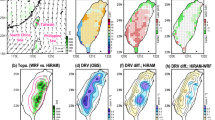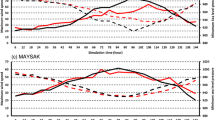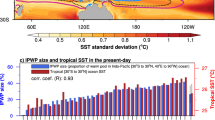Abstract
The agrarian-based socioeconomic livelihood of densely populated South Asian countries is vulnerable to modest changes in Indian summer monsoon (ISM) rainfall1,2,3. How the ISM rainfall will evolve is a question of broad scientific and socioeconomic importance3,4,5,6,7,8,9. In response to increased greenhouse gas (GHG) forcing, climate models commonly project an increase in ISM rainfall4,5,6,7,8,9. This wetter ISM projection, however, does not consider large model errors in both the mean state and ocean warming pattern9,10,11. Here we identify a relationship between biases in simulated present climate and future ISM projections in a multi-model ensemble: models with excessive present-day precipitation over the tropical western Pacific tend to project a larger increase in ISM rainfall under GHG forcing because of too strong a negative cloud–radiation feedback on sea surface temperature. The excessive negative feedback suppresses the local ocean surface warming, strengthening ISM rainfall projections via atmospheric circulation. We calibrate the ISM rainfall projections using this ‘present–future relationship’ and observed western Pacific precipitation. The correction reduces by about 50% of the projected rainfall increase over the broad ISM region. Our study identifies an improved simulation of western Pacific convection as a priority for reliable ISM projections.
This is a preview of subscription content, access via your institution
Access options
Access Nature and 54 other Nature Portfolio journals
Get Nature+, our best-value online-access subscription
$29.99 / 30 days
cancel any time
Subscribe to this journal
Receive 12 print issues and online access
$209.00 per year
only $17.42 per issue
Buy this article
- Purchase on Springer Link
- Instant access to full article PDF
Prices may be subject to local taxes which are calculated during checkout




Similar content being viewed by others
References
Gadgil, S. & Gadgil, S. The Indian monsoon, GDP and agriculture. Econ. Polit. Weekly 41, 4887–4895 (2006).
Wahl, E. R. & Morrill, C. Toward understanding and predicting monsoon patterns. Science 328, 437–438 (2010).
Douglas, I. Climate change, flooding and food security in south Asia. Food Secur. 1, 127–136 (2009).
Christensen, J. H. et al. in Climate Change 2013: The Physical Science Basis (eds Stocker, T. F. et al.) 1217–1308 (IPCC, Cambridge Univ. Press, 2014).
Meehl, G. A. & Washington, W. M. South Asian summer monsoon variability in a model with doubled atmospheric carbon dioxide concentration. Science 260, 1101–1104 (1993).
Turner, A. G. & Annamalai, H. Climate change and the South Asian summer monsoon. Nat. Clim. Change 2, 587–595 (2012).
May, W. Simulated changes of the Indian summer monsoon under enhanced greenhouse gas conditions in a global time-slice experiment. Geophys. Res. Lett. 29, 1118 (2002).
Sooraj, K. P., Terray, P. & Mujumdar, M. Global warming and the weakening of the Asian summer monsoon circulation: assessments from the CMIP5 models. Clim. Dynam. 45, 233–252 (2015).
Chen, X. & Zhou, T. Distinct effects of global mean warming and regional sea surface warming pattern on projected uncertainty in the South Asian summer monsoon. Geophys. Res. Lett. 42, 9433–9439 (2015).
Lin, J. L. The double-ITCZ problem in IPCC AR4 coupled GCMs: ocean-atmosphere feedback analysis. J. Clim. 20, 4497–4525 (2007).
Li, G., Xie, S. P. & Du, Y. Monsoon-induced biases of climate models over the tropical Indian Ocean. J. Clim. 28, 3058–3072 (2015).
Webster, P. J. & Yang, S. Monsoon and ENSO: selectively interactive systems. Q. J. R. Meteorol. Soc. 118, 877–926 (1992).
Goswami, B. N., Krishnamurthy, V. & Annamalai, H. A broad-scale circulation index for the interannual variability of the Indian summer monsoon. Q. J. R. Meteorol. Soc. 125, 611–633 (1999).
Annamalai, H., Hafner, J., Sooraj, K. P. & Pillai, P. Global warming shifts the monsoon circulation, drying South Asia. J. Clim. 26, 2701–2718 (2013).
Kumar, K. K., Rajagopalan, B., Hoerling, M. P., Bates, G. & Cane, M. Unraveling the mystery of Indian monsoon failure during El Niño. Science 314, 115–119 (2006).
Bollassina, M. A., Ming, Y. & Ramaswamy, V. Anthropogenic aerosols and the weakening of the South Asian summer monsoon. Science 224, 502–505 (2011).
Goswami, B. N., Venugopal, V., Sengupta, D., Madhusoodanan, M. & Xavier, P. K. Increasing trend of extreme rain events over India in a warming environment. Science 314, 1442–1445 (2006).
Boos, W. R. & Kuang, Z. Dominant control of the South Asian monsoon by orographic insulation versus plateau heating. Nature 463, 218–222 (2010).
Roxy, M. K. et al. Drying of Indian subcontinent by rapid Indian Ocean warming and a weakening land–sea thermal gradient. Nat. Commun. 6, 7423 (2015).
Bollasina, M. A. Hydrology: probing the monsoon pulse. Nat. Clim. Change 4, 422–423 (2014).
Jain, S. K. & Kumar, V. Trend analysis of rainfall and temperature data for India. Curr. Sci. 102, 37–49 (2012).
Gadgil, S., Vinayachandran, P. N., Francis, P. A. & Gadgil, S. Extremes of the Indian summer monsoon rainfall, ENSO and equatorial Indian Ocean oscillation. Geophys. Res. Lett. 31, L12213 (2004).
Taylor, K. E., Ronald, J. S. & Meehl, G. A. An overview of CMIP5 and the experiment design. Bull. Am. Meteorol. Soc. 93, 485–498 (2012).
Held, I. M. & Soden, B. J. Robust responses of the hydrological cycle to global warming. J. Clim. 19, 5686–5699 (2006).
Brown, J. R., Moise, A. F., Colman, R. & Zhang, H. Will a warmer world mean a wetter or drier Australian monsoon? J. Clim. 29, 4577–4596 (2016).
Meehl, G. A. & Washington, W. M. El Niño-like climate change in a model with increased atmospheric CO2 concentrations. Nature 382, 56–60 (1996).
Gill, A. E. Some simple solutions for heat-induced tropical circulation. Q. J. R. Meteorol. Soc. 106, 447–462 (1980).
Shaman, J. & Tziperman, E. The effect of ENSO on Tibetan Plateau snow depth: a stationary wave teleconnection mechanism and implications for the South Asian monsoons. J. Clim. 18, 2067–2079 (2005).
Boe, J. L., Hall, A. & Qu, X. September sea-ice cover in the Arctic Ocean projected to vanish by 2100. Nat. Geosci. 2, 341–343 (2009).
Cox, P. M. et al. Sensitivity of tropical carbon to climate change constrained by carbon dioxide variability. Nature 494, 341–344 (2013).
Adler, R. F. et al. The version 2 Global Precipitation Climatology Project (GPCP) monthly precipitation analysis (1979-present). J. Hydrometeorol. 4, 1147–1167 (2003).
Dai, A. et al. The relative roles of upper and lower tropospheric thermal contrasts and tropical influences in driving Asian summer monsoons. J. Geophys. Res. 118, 7024–7045 (2013).
Sandeep, S. & Ajayamohan, R. S. Poleward shift in Indian summer monsoon low level Jetstream under global warming. Clim. Dynam. 45, 337–351 (2015).
Gent, P. R. et al. The Community Climate System Model version 4. J. Clim. 24, 4973–4991 (2011).
Hurrell, J., Hack, J., Shea, D., Caron, J. & Rosinski, J. A new sea surface temperature and sea ice boundary data set for the Community Atmosphere Model. J. Clim. 21, 5145–5153 (2008).
Li, G. & Xie, S. P. Origins of tropical-wide SST biases in CMIP multi-model ensembles. Geophys. Res. Lett. 39, L22703 (2012).
Shiogama, H. et al. Observational constraints indicate risk of drying in the Amazon basin. Nat. Commun. 2, 253 (2011).
Collins, M. et al. Quantifying future climate change. Nat. Clim. Change 2, 403–409 (2012).
Bracegirdle, T. J. & Stephenson, D. B. On the robustness of emergent constraints used in multimodel climate change projections of Arctic warming. J. Clim. 26, 669–678 (2013).
Li, G., Xie, S. P. & Du, Y. A robust but spurious pattern of climate change in model projections over the tropical Indian Ocean. J. Clim. 29, 5589–5608 (2016).
Acknowledgements
We are grateful for helpful comments from L. Sun and R. Lu. This work was supported by the Natural Science Foundation of China (41521005 and 41406026), the National Basic Research Program of China (2012CB955603), the Guangdong Natural Science Funds for Distinguished Young Scholar (2015A030306008), the Youth Innovation Promotion Association CAS, and the Pearl River S&T Nova Program of Guangzhou (201506010094). S.-P.X. was supported by the US National Science Foundation (1637450). Z.C. was supported by the Open Project Program of State Key Laboratory of Tropical Oceanography (LTOZZ1603). We acknowledge the climate modelling groups for producing and making available their model output, the WCRP’s Working Group on Coupled Modeling (WGCM) for organizing the CMIP5 analysis activity, the Program for Climate Model Diagnostics and Intercomparison (PCMDI) for collecting and archiving the CMIP5 multi-model data, and the Office of Science, US Department of Energy for supporting these datasets in partnership with the Global Organization for Earth System Science Portals.
Author information
Authors and Affiliations
Contributions
G.L. designed the study and performed the analysis with feedback from S.-P.X. G.L. and S.-P.X. wrote the paper. C.H. and Z.C. carried out the CAM4 experiments.
Corresponding author
Ethics declarations
Competing interests
The authors declare no competing financial interests.
Supplementary information
Supplementary Information
Supplementary Information (PDF 903 kb)
Rights and permissions
About this article
Cite this article
Li, G., Xie, SP., He, C. et al. Western Pacific emergent constraint lowers projected increase in Indian summer monsoon rainfall. Nature Clim Change 7, 708–712 (2017). https://doi.org/10.1038/nclimate3387
Received:
Accepted:
Published:
Issue Date:
DOI: https://doi.org/10.1038/nclimate3387
This article is cited by
-
Future climate change in the Northern Indian Ocean as simulated with a high-resolution regional earth system model
Climate Dynamics (2024)
-
The changes in south Asian summer monsoon circulation during the mid-Piacenzian warm period
Climate Dynamics (2024)
-
Asymmetric response of South Asian summer monsoon rainfall in a carbon dioxide removal scenario
npj Climate and Atmospheric Science (2023)
-
Intermodel uncertainty in response of the Pacific Walker circulation to global warming
Climate Dynamics (2023)
-
Changes in Sahel summer rainfall in a global warming climate: contrasting the mid-Pliocene and future regional hydrological cycles
Climate Dynamics (2023)



